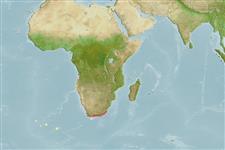>
Blenniiformes (Blennies) >
Clinidae (Clinids)
Etymology: Blennioclinus: Diminutive of blennius, Greek,blenios = mucus + Greek, klinein, kline = sloping and bed, due to the four apophyses of sphenoid bone (Ref. 45335).
More on author: Valenciennes.
Environment: milieu / climate zone / depth range / distribution range
Ecologia
marino demersale. Subtropical
Southeast Atlantic: Lüderitzbucht, Namibia and from off Melkbosch Beach (northwest coast of Cape Peninsula) to the Kei River in South Africa.
Size / Peso / Age
Maturity: Lm ? range ? - ? cm
Max length : 15.0 cm TL maschio/sesso non determinato; (Ref. 5496)
Short description
Chiavi di identificazione | Morfologia | Morfometria
Spine dorsali (totale) : 26 - 30; Raggi dorsali molli (totale) : 8 - 11; Spine anali: 2; Raggi anali molli: 19 - 25. Sides mottled; red margined, bright blue semicircular spot behind pectoral fins (Ref. 5496). Juveniles dark red in color, with 'bubbles' along sides (Ref. 5496).
Found on bottoms with pebbles, sea urchins and sea anemones.
Life cycle and mating behavior
Maturities | Riproduzione | Spawnings | Egg(s) | Fecundities | Larve
Smith, M.M., 1986. Clinidae. p. 758-769. In M.M. Smith and P.C. Heemstra (eds.) Smiths' sea fishes. Springer-Verlag, Berlin. (Ref. 5496)
IUCN Red List Status (Ref. 130435)
Threat to humans
Harmless
Human uses
Strumenti
Special reports
Download XML
Fonti Internet
Estimates based on models
Preferred temperature (Ref.
123201): 15.6 - 25.2, mean 19.9 °C (based on 90 cells).
Phylogenetic diversity index (Ref.
82804): PD
50 = 0.7500 [Uniqueness, from 0.5 = low to 2.0 = high].
Bayesian length-weight: a=0.00513 (0.00223 - 0.01182), b=3.06 (2.86 - 3.26), in cm total length, based on LWR estimates for this (Sub)family-body shape (Ref.
93245).
Trophic level (Ref.
69278): 3.3 ±0.54 se; based on food items.
Resilienza (Ref.
120179): Alto, tempo minimo di raddoppiamento della popolazione meno di 15 mesi (Preliminary K or Fecundity.).
Fishing Vulnerability (Ref.
59153): Low vulnerability (10 of 100).
